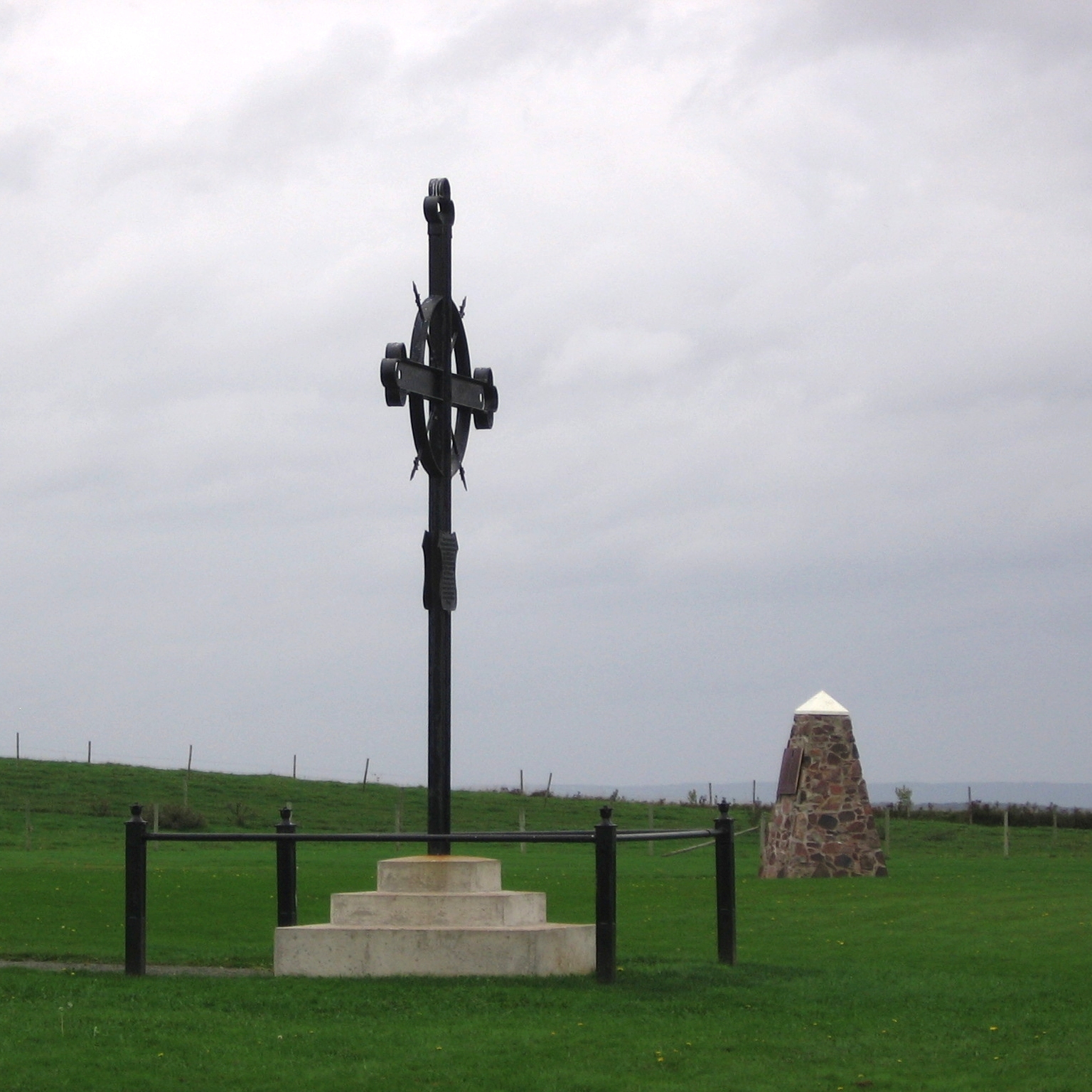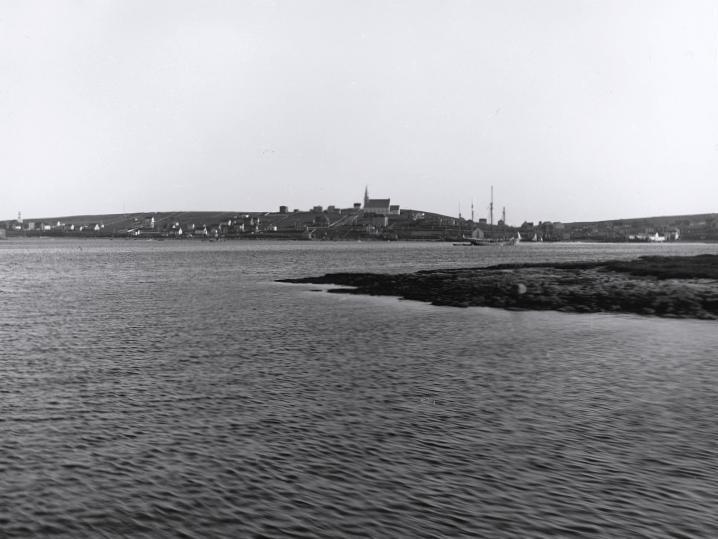|
Siege Of Grand Pré
The siege of Grand Pré happened during Father Le Loutre's War and was fought between the British and the Wabanaki Confederacy and Acadian militia. The siege happened at Fort Vieux Logis, Grand-Pré (present-day Hortonville, Nova Scotia). The native and Acadia militia laid siege to Fort Vieux Logis for a week in November 1749. One historian states that the intent of the siege was to help facilitate the Acadian Exodus from the region. Historical context Despite the British Conquest of Acadia in 1710, Nova Scotia remained primarily occupied by Catholic Acadians and Mi'kmaq. By the time Cornwallis had arrived in Halifax, there was a long history of the Wabanaki Confederacy (which included the Mi'kmaq) protecting their land by killing British civilians along the New England/Acadia border in Maine (See the Northeast Coast Campaigns 1688, 1703, 1723, 1724, 1745, 1746, 1747). To prevent the establishment of Protestant settlements in the region, Mi'kmaq raided the early Bri ... [...More Info...] [...Related Items...] OR: [Wikipedia] [Google] [Baidu] |
Hortonville, Nova Scotia
Hortonville is a community in the Canada, Canadian province of Nova Scotia, located in Kings County, Nova Scotia, Kings County at the mouth of the Gaspereau River (Nova Scotia), Gaspereau River and is part of the Grand-Pré, Nova Scotia, Landscape of Grand Pré UNESCO World Heritage Site. The site of Fort Vieux Logis is located by the river at Hortonville, built by the British during Father Le Loutre's War to control the nearby Acadian settlements at Grand Pre, Nova Scotia, Grand Pre. The landing at Hortonville was used in 1755 to deport the majority of Acadians from Grand Pre during the Bay of Fundy Campaign (1755), Bay of Fundy Campaign of the Expulsion of the Acadians and is today marked by an Acadian Memorial Cross. The same landing was used in 1760 when New England Planters, led by Robert Denison, arrived to re-settle the Grand Pre area and is marked by a National Historic Sites of Canada, National Historic Sites and Monuments Board plaque commemorating the Planters. The sett ... [...More Info...] [...Related Items...] OR: [Wikipedia] [Google] [Baidu] |
Fort Anne
Fort Anne is a historic fort protecting the harbour of Annapolis Royal, Nova Scotia. It was built by Scottish settlers in August 1629 as Charles Fort. For the first 120 years of the fort's service period, the settlement of Port Royal, later Annapolis Royal, was the capital of the New France colony of Acadia and British North America colony of Nova Scotia. In 1917, Fort Anne became the first National Historic Site of Canada. Although no longer in active service, it is the oldest extant fort in Canada. Fort Anne has provided more defensive service than any other fort in North America, having been attacked and blockaded at least 19 times over a service period of 225 years, from the Acadian Civil War through to the American Revolutionary War. The fort also contains the oldest military building in Canada and the oldest building administered by Parks Canada, the 1708 powder magazine. The importance of Port Royal as a settlement site was first recognised by Pierre Dugua, Lieutenan ... [...More Info...] [...Related Items...] OR: [Wikipedia] [Google] [Baidu] |
Fort Lawrence
Fort Lawrence was a British fort built during Father Le Loutre's War and located on the Isthmus of Chignecto (in the modern-day community of Fort Lawrence). Father Le Loutre's War Despite the British Conquest of Acadia in 1710, Nova Scotia remained primarily occupied by Catholic Acadians and Mi'kmaq. Father Le Loutre's War began after Edward Cornwallis arrived to establish Halifax with 13 transports on June 21, 1749. The British quickly began to build other settlements. To guard against Mi'kmaq, Acadian and French attacks on the new Protestant settlements, British fortifications were erected in Halifax (1749), Bedford ( Fort Sackville) (1749), Dartmouth (1750), Lunenburg (1753), and Lawrencetown (1754). Within 18 months of establishing Halifax, the British also took firm control of peninsula Nova Scotia by building fortifications in all the major Acadian communities: present-day Windsor ( Fort Edward); Grand-Pré ( Fort Vieux Logis) and Chignecto (Fort Lawrence). A British ... [...More Info...] [...Related Items...] OR: [Wikipedia] [Google] [Baidu] |
Fort Edward (Nova Scotia)
Fort Edward is a National Historic Site of Canada in Windsor, Nova Scotia, (formerly known as Pisiguit) and was built during Father Le Loutre's War (1749-1755). The British built the fort to help prevent the Acadian Exodus from the region. The Fort is most famous for the role it played both in the Expulsion of the Acadians (1755) and in protecting Halifax, Nova Scotia from a land assault in the American Revolution. While much of Fort Edward has been destroyed, including the officers' quarters (which burned down in 1922) and barracks, the blockhouse that remains is the oldest extant in North America. A cairn was later added to the site. Father Le Loutre's War Despite the British Conquest of Acadia in 1710, Nova Scotia remained primarily occupied by ethnic French Catholic Acadians and Mi'kmaq. Father Le Loutre's War began when Edward Cornwallis arrived with 13 transports on 21 June 1749 to establish Halifax. To guard against Mi'kmaq, Acadian, and French attacks on the new Bri ... [...More Info...] [...Related Items...] OR: [Wikipedia] [Google] [Baidu] |
Halifax Regional Municipality
Halifax is the capital and most populous municipality of the Provinces and territories of Canada, Canadian province of Nova Scotia, and the most populous municipality in Atlantic Canada. As of 2024, it is estimated that the population of the Halifax Census Metropolitan Area, CMA was 530,167, with 348,634 people in its urban area. The regional municipality consists of four former municipalities that were Amalgamation (politics), amalgamated in 1996: History of Halifax (former city), Halifax, Dartmouth, Nova Scotia, Dartmouth, Bedford, Nova Scotia, Bedford, and Halifax County, Nova Scotia, Halifax County. Halifax is an economic centre of Atlantic Canada, home to a concentration of government offices and private companies. Major employers include the Canadian Armed Forces, Department of National Defence, Dalhousie University, Nova Scotia Health Authority, Saint Mary's University (Halifax), Saint Mary's University, the Halifax Shipyard, various levels of government, and the Port of ... [...More Info...] [...Related Items...] OR: [Wikipedia] [Google] [Baidu] |
Edward Cornwallis
Edward Cornwallis ( – 14 January 1776) was a British career military officer and member of the aristocratic Cornwallis family, who reached the rank of Lieutenant General. After Cornwallis fought in Scotland, putting down the Jacobite rebellion of 1745, he was appointed Groom of the Chamber for King George II (a position he held for the next 17 years). He was then made Governor of Nova Scotia (1749–1752), one of the colonies in North America, and assigned to establish the new town of Halifax, Nova Scotia. Later Cornwallis returned to London, where he was elected as MP for Westminster and married the niece of Robert Walpole, Great Britain's first Prime Minister. Cornwallis was next appointed as Governor of Gibraltar. Cornwallis arrived in Nova Scotia during a period of conflict with the local indigenous Miꞌkmaq peoples of peninsular Nova Scotia. The Mi'kmaq opposed the founding of Halifax and conducted war raids on the colony. Cornwallis responded with the extirpati ... [...More Info...] [...Related Items...] OR: [Wikipedia] [Google] [Baidu] |
Canso, Nova Scotia
Canso is an unincorporated community and former incorporated town in Guysborough County, Nova Scotia, Canada. Canso lies on the far north eastern tip of mainland Nova Scotia at the mouth of Chedabucto Bay. It was incorporated as a town in 1901. In January 2012, it ceased to be a separate town, and was amalgamated into the Municipality of the District of Guysborough in July 2012. The area was first settled as a fishing settlement in the 1600's. The construction of a British fort in the village in 1720 was instrumental in contributing to the outbreak of Dummer's War in 1722. The town is of national historic importance because it was one of only two British settlements in Nova Scotia prior to the establishment of Halifax (1749). Canso played a key role in the defeat of Fortress of Louisbourg. Today, the town attracts people internationally for the annual Stan Rogers Folk Festival. Geography The community is located on the southern shore of Chedabucto Bay. The southern l ... [...More Info...] [...Related Items...] OR: [Wikipedia] [Google] [Baidu] |
Shelburne, Nova Scotia
Shelburne is a town located in southwestern Nova Scotia, Canada. History Shelburne lies at the southwest corner of Nova Scotia, at roughly the same latitude as Portland, Maine, in the United States. The Mi'kmaq people, Mi'kmaq call the large and well-sheltered harbour ''Logumkeegan'' or ''Sogumkeagum.'' The first settlers arrived in the Shelburne region around 13,000 years ago. The Mi'kmaq First Nations travelled by canoe along the Roseway River, setting up encampments along the shores in summer. Mi'kmaq residents referred to Shelburne's sheltered harbour as Logumkeegan or Sogumkeagum. Prior to the arrival of Europeans in the 1500s, the territory of Mi'kma'ki was divided into seven districts, each led by a District Chief. The displacement of the Nova Scotia's Mi'kmaq communities consists of a long and painful history including the introduction of European diseases in the 1500s, the occupation of unceded land, as well as removal of Indigenous children from their homes in the 20 ... [...More Info...] [...Related Items...] OR: [Wikipedia] [Google] [Baidu] |
Royal Nova Scotia Historical Society
The Royal Nova Scotia Historical Society is a historical society in Halifax, Nova Scotia that was founded in 1878 and is the third oldest in Canada (The Literary and Historical Society of Quebec is the first, founded in 1824, followed by the York Pioneers which was founded in 1869.) The Society is a voluntary organization that operates without an office or paid staff. The Society first published the Nova Scotia Historical Quarterly and then the Nova Scotia Historical Review. Eventually, the publication was named the Collections of the Royal Nova Scotia Historical Society and now it is known as the Journal of the Royal Nova Scotia Historical Society. Notable members *Thomas Beamish Akins (1809–1921), Nova Scotia's first Commissioner of Public Records. *John Forrest (1842–1920), President of Dalhousie University, who served as the Society's President from 1905 to 1906. * Archibald MacMechan (1862–1933), Professor at Dalhousie University. * Harry Piers (1870–1940), histori ... [...More Info...] [...Related Items...] OR: [Wikipedia] [Google] [Baidu] |






